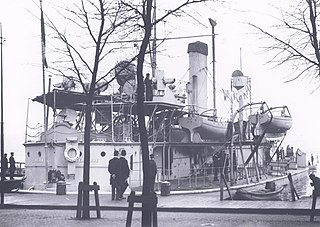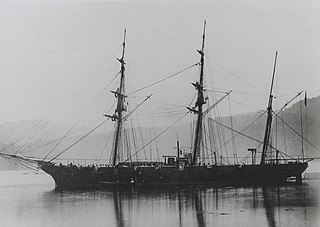The Adder-class monitors were a group of six ironclad monitors built for the Royal Netherlands Navy in the 1870s.

The Heiligerlee-class monitors were a group of 5 ironclad monitors built for the Royal Netherlands Navy in the late 1860s.

HNLMS Heiligerlee, formerly known as Panter, was a Heiligerlee-class monitor built in England for the Royal Netherlands Navy in the 1860s. Among the new ships built for the Dutch navy the Heiligerlee was the first true monitor: a ship with shallow draught, only a few (heavy) guns and decent armor. These characteristics made her very suitable to operate way inland in the Dutch delta.

HNLMS Cereberus, was a Heiligerlee-class monitor built in Amsterdam for the Royal Netherlands Navy in the 1860s. The Cerberus was a true monitor: a ship with shallow draught, only a few (heavy) guns and decent armor. These characteristics made her very suitable to operate way inland in the Dutch delta.

The Djambi class was a class of steam corvettes of the Royal Netherlands Navy. The class comprised Djambi, Zoutman, Willem, Leeuwarden, Metalen Kruis and Curaçao. Later two ships of a slightly revised type were built, the Zilveren Kruis and Van Galen

The Watergeus class was a class of screw sloop-of-war of the Royal Netherlands Navy. The class comprised the 'Watergeus' and the Marnix. A third ship that had been planned was cancelled.

The Zilveren Kruis class was a class of two steam corvettes of the Royal Netherlands Navy. The class comprised the Zilveren Kruis and the Van Galen.

The Groningen class was a class of steam corvettes of the Royal Netherlands Navy. The class comprised Groningen, Citadel van Antwerpen and Vice-Admiraal Koopman

The Medusa class was a class of 2 steam corvettes with auxiliary power of the Royal Netherlands Navy. The class comprised the Medusa, the first Dutch warship with screw propulsion, and the Prinses Amelia.

HNLMS Djambi, was the lead ship of the Djambi-class, built for the Royal Netherlands Navy from the late 1850's. She was in the 1864 Shimonoseki affair and in the 1873 First Aceh Expedition. She became unfit for service after serving for only 13 years.

HNLMS Wassenaar, was a unique ship built for the Royal Netherlands Navy.

The Evertsen class was a class of steam frigates of the Royal Netherlands Navy. The class comprised Evertsen and Zeeland

HNLMS Adolf van Nassau, was a unique ship built for the Royal Netherlands Navy.

The Vesuvius class was a class of steam screw sloops of the Royal Netherlands Navy. The class comprised Vesuvius, Cornelis Dirks, Reinier Claessen, Het Loo, Reteh and Prinses Maria.

Van Vlissingen en Dudok van Heel was a famous nineteenth-century Dutch machine factory. It built steam engines and machinery for the sugar industry and for maritime purposes, as well ships, rolling stock and large metal structures like the Moerdijk bridge and a floating dock. In 1871 it was reorganized to become the public company Koninklijke Fabriek van Stoom- en andere Werktuigen. In a second reorganization in 1890, parts of it were saved and continued under the name Koninklijke Nederlandsche Fabriek van Werktuigen en Spoorwegmaterieel, renamed to Werkspoor in 1927.

Wilton's Dok- en Werf Maatschappij was a Dutch shipyard active as an independent company from 1854 till 1929. At first it was simply known as 'Wilton'. In 1921 the final Dutch name became: 'Wilton's Dok- en Werf Maatschappij NV', the equivalent of 'Wilton Engineering and Slipway Company'. Wilton started as a traditional smithy and expanded in machinery. It specialized in ship repairs, but also became a shipyard. At first only for fresh water ships. In spite of multiple name changes the company was commonly referred to as 'Wilton'. In 1929 a merger with Fijenoord led to a new company known as Wilton-Fijenoord.

Fijenoord was a shipbuilding and machine factory in Rotterdam the Netherlands from 1823 to 1929. In 1929 it merged with Wilton to become Wilton-Fijenoord.

The Pontianak class was a class of steam screw sloops of the Royal Netherlands Navy.

The Riouw class was a class of four steam screw sloops of the Royal Netherlands Navy. They were the first composite built ships of the Dutch navy.


















